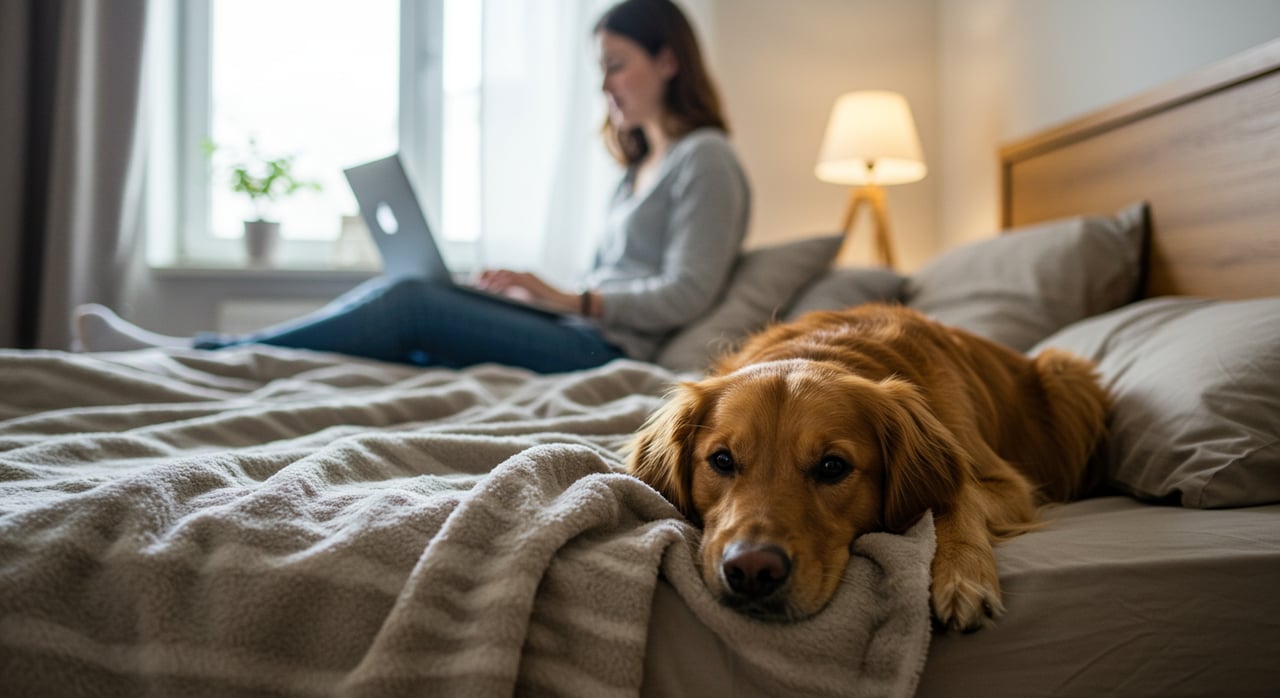Moving is stressful all on its own, but when you add in the complications that kids or pets (or both) can bring to the mix, it can feel downright impossible. Depending on the age of your children and whether your fur baby is a cat or a dog, some moves can be easier than others, but any stress you’re feeling can manifest exponentially in your dependents.
The good news is that with a little bit of foresight and a lot of planning, you can smooth the way for your kids, pets, or both to ensure the move is as low-stress for them as possible. And when your children (of any species) are happier, you’ll also feel some relief. Win-win! Before your move your household to a new residence, read these tips, then make your plan.
Consider the Timing
There really isn’t an “easy” time to move your household, but there are definitely some life events that make moving more difficult for everybody. If there’s been a death in the family or you’re getting a divorce, then both the children and the pets are likely to already be feeling some anxiety. Adding a move on top of that is generally not the best plan if it’s at all possible to avoid it.
Delaying a move by six months to a year to give all the dependents in the household time to adjust might be completely impossible, which is understandable — life happens out of our control all the time. But think about whether you can offer your babies a respite from change for at least a few months so that you aren’t heaping change after change on kids or animals.
Research Your New Area
When you tell your kids about the move, they’re going to have questions. Your pets may not have quite as many questions, but they’ll still want the assurance of some consistency, like the ability to go on a walk or the availability of their food.
Do some research into schools, parks, walking trails, pet stores, veterinarians, pediatricians, local restaurants and attractions, libraries, and more. Find some gems that you know will excite your kids when they hear about them, or your pets when they discover them, and be able to answer questions honestly. Older kids might want to help with research, and you should encourage them to dig into whatever they want to know about their new home, but it really helps to have a solid understanding of where you’re going before you break the news.
Talk to Your Kids About the Move
There are plenty of age-appropriate conversations you can have with your children when you’re getting ready to move in order to help them prepare emotionally for the change. (Unfortunately, this doesn’t work nearly so well with pets, but if you think that your animals understand you, feel free to give them a rundown, too!)
Explain to your children why you have to move and talk to them about what it will mean. Depending on how old they are, their concerns will vary. Younger kids might have more questions about what will happen to their toys, while adolescents are likely to be more concerned about school and friends.
This is a good time to share some of what you’ve learned about your new area, such as whether the local grocery store carries their favorite snacks, or what their new school will be like. You don’t want to overwhelm your kids, but help them get excited about the change by emphasizing some of the positive differences between here and there.
Emphasize Similarity, Too
People (and animals) dread change because they’re afraid of the unknown. So while you’re having any moving discussions, make a point to talk about what isn’t going to change. If you’ve always hosted Thanksgiving, then tell your kids they’ll still be celebrating by cooking with you in the kitchen. If you take a regular vacation every summer to visit grandparents, talk about when you’ll do that. Tell your sports fans that they’ll still be able to watch or play their favorites, or emphasize to your bookworm that the library is in the same district and access to all the same books is guaranteed.
Pets won’t be as able to appreciate these discussions, but you can do them a favor by thinking about how you can work to emphasize similarity when they get to their new environment. Can you set up their favorite “room” exactly the way they know it right now? What can you do to acclimate them to some of the new sights and sounds and smells they’ll encounter during the move?
Get Your Pets Used to Carriers, Kennels, or Cars
On that note, if your cat doesn’t see the cat carrier except when you’re getting ready to take him to the vet, and your dog isn’t used to riding in your car, then it’s time for you to help them get accustomed to some of those unfamiliar items and experiences. The more familiar they become, the easier time your pet will have on moving day.
Take any carriers out from whatever dusty closet you’ve stashed them and open the doors. Leave them out for as long as you can and give your cats the chance to walk in and out at will. Take your dogs on car rides to the pet store, the park, and other fun places where she can get excited, and help her learn to identify car rides as an adventure.
If you can, it probably also isn’t a terrible idea to leave out some empty moving boxes and gradually fill them with your things. Your pets will become accustomed to the boxes as a matter of course.
Make a Moving Day Plan
Moving day itself is going to be peak stressful for you, the pets, and the kids, so to remove some of that stress in advance, plan the heck out of the day itself. For kids, this may involve coming up with safe ways they can participate, or alternatively, planning to get them the heck out of the way while the move is actually taking place. If you have friends or grandparents who’ve offered to help watch the kids, take them up on it!
For pets, a moving day plan may involve dropping them off at a pet hotel or doggie day care, or keeping their favorite room as intact as possible and locking them inside while everything gets moved out of the house. Change is especially hard on animals, and leaving doors open while people move furniture and boxes outside gives them too much opportunity to escape, so there aren’t really any great options, here. If you have the chance to acclimate them to the pet care facilities in advance, then this might be the least stressful for your fur babies.
Give Your Kids Some Choices
Maybe you can let the kids pick out their own bedrooms in the new house, or even help you search for possible homes online. Even if that’s a stretch too far, there are plenty of ways you can give children agency in the move, including letting them pick the paint color in their new room, or decide how to arrange the furniture, or maybe select a new bedding set or framed poster for their space. The more freedom you give your kids to make decisions, the easier it will be to help them get excited about the move as a whole.
Consider Hiring Movers
Hiring movers can be like hiring someone to clean the house — perhaps you feel like packing and moving is something you should be able to do yourself. But also much like hiring someone to clean the house, the amount of stress that hiring a pro can alleviate is noteworthy and often well worth the expense.
Professional packers and movers have turned the chaos of moving into a science. Their efficiency and expertise can save you days of your own life, and they can also allow you to make alternate plans for moving day itself. Maybe you can take the kids to an amusement park or the dog to the dog park while your partner supervises the move?
Secure Your Animals While the Move is Happening
Two things you already know you don’t want to be doing on moving day: chasing your leashless, collarless dog through the neighborhood or coaxing your cat out from underneath the porch. If sending them to day care or having a trusted friend watch them isn’t an option, then make sure you’re prepared to keep your pets confined and contained while the move erupts around them.
Secure them behind a door they can’t open and leave water, litter boxes, toys, and whatever else they might need for a few hours out and available for them. Make sure you have a loud, obnoxious sign that you can fasten on the door warning anyone who might open it that there are freaked-out pets behind it and asking them to leave it shut.
Find an Activity to Keep Everyone Occupied During the Move
If you can get your pets a new, complicated toy, or buy some puzzle books for your kids, you’ll be able to distract them much more easily. Moving parents or pet-owners who hire movers might have a lot more flexibility here to manifest a distraction — take the kids to a movie or go on a long hike with your pup, or sprinkle some catnip on the scratching post for your kitten.
Pack (and Remove Items) While They’re Asleep …
Kids have the strangest habit of declaring that the baby toy they haven’t touched for years is their new most favorite, most sentimentally valued of all their possessions. Decluttering your living area is a fantastic idea before you move, and sometimes this can be done most easily after the children are asleep.
This tactic really works best for the youngest kids, who are most inclined to forget that they ever owned a butterfly elephant stuffed animal. For older kids, try a different approach.
…or Let Your Kids Help Pack Their Own Things
Older children will appreciate the chance to find security in the familiar by packing up their own rooms and possessions. Let them decide what to keep and what to toss, and help them get excited by talking about how they’ll arrange their new room. Ask them what you can do to help make their new living space feel perfect for them.
Even younger kids can take advantage of the excitement of moving if you let them pack a small box, especially if you’re letting them pack a few toys and treasured items to bring with them in the car or on the plane.
Take as Much Help as You Can Get
Friends, family, and neighbors often offer to help with a move, and many movers don’t quite know how to take them up on the offer. If you trust them with your kids or pets, then having them entertain or watch your babies while you deal with the logistics can be a great way to leverage their help.
This doesn’t have to happen only on the day of the move, either. Kids appreciate trips to the ice-cream parlor or movie theater at just about any time, and dogs like being walked, and cats enjoy playing with feather toys, too. If you can’t think of anything else for your potential helpers to do, having them shower your dependents with attention is always a good option.
Give Them Time to Say Goodbye
Pets might not understand the meaning of leaving, but it’s all too acute for kids. Talk to them about what and whom they think they’ll miss the most, and give them time and opportunities to spend with those beloved spaces and people. For kids, throwing a “see you later” party or giving them a ritual tour through the empty house before you leave for good can help them adjust to the change more smoothly.
Help Them Make a Plan for Keeping in Touch
Kids can also benefit by talking through a plan to keep in touch with their best friends and relatives they’re leaving behind. This is easier than ever in the age of technology, so you can help them exchange email addresses with their friends or make sure that they’re connected via phone, but it might also help to talk about plans to come back and visit if that’s in the cards for you. Giving kids something to look forward to if they’re having trouble adjusting in their new home can make a huge difference.
Pets aren’t able to make their own plans to keep in touch with loved ones, but if it’s feasible for you to do it for them, then you should do what you can to ensure that they still get to see favorite people or animals every now and again. Maybe your catsitter can agree to stop by when he’s next visiting your new town, or your brother and fellow dog enthusiast could plan a weekend trip soon.
Get Your Documents in Order
Before you leave, make sure you’ve made plans for transferring your kids’ medical and school records from one entity to another, and do the same for your pets’ veterinary records. Any other legal or medical documents that you might need should be considered and managed before you go — because when you really need those items in a hurry, it’s almost never possible to acquire them, so tackle it on the front end.
Prepare ‘overnight’ Kits
If you’re going to be traveling for more than a day, whether on a plane or in the car, then you’ll want to get some overnight bags ready for the kids and the pets. Kids can help with this on their own and often find some comfort in choosing the toys and books that will accompany them on the journey, and pets will feel similar comfort if you can surround them with smells and items that are familiar and dear to them.
Don’t forget about medication for any of your dependents, and make sure you’re packing plenty of food and water for your pets. It’s also wise to stash an extra leash and collar or harness for your dog; you don’t want to be tempted to let any animals out of your car before they’re fully secured.
Pets Should Travel With You
If it’s at all possible, the stress of the move will be less acute for your fur babies if you can bring them with you in the vehicle you’re driving. If your pet is in a carrier or a kennel, draping a blanket or sheet on top of it can help with any distress caused by unfamiliar landscapes or even just being inside a rapidly moving car.
Dogs should also be secured. Consider getting a gate that will keep your dog in a specific area of your car but still allow the pup to move around if they like. Give them toys and talk to them during the drive, and don’t open your car door until the dog is leashed.
Secure Hotels (if Needed) in Advance
Long car trips sometimes mean stops at hotels in between, so if this is in the cards for you, do a little bit of research to see what’s available and make sure your kids and pets will be comfortable there. Look for pet-friendly hotels if it’s relevant, and maybe if you have an option between a hotel with a pool and one without, opt for the pool so you can hype it up to the kids.
Unpack ‘their’ Rooms First
For kids, unpacking their bedroom first can help them start feeling at home more quickly than you’d expect. See if you can get their bed and bedding set up at the least, and try to prioritize their space. Kids will also be spending time in the kitchen and play areas (if you have one), so those might go next in your order of priorities.
When you’re moving in, much like moving out, pets should be secured in a room until everyone is finished opening and closing doors. If you can, try to set up a scratching post or dog bed in the room — make it as close to the room that was most “theirs” in your old place. Give them water, feed them, show them where their toys are, and take some time to get settled before you let them out to explore.
Once you do open the door, give your dog (and your cat, if it’s inclined) a tour of the new space. Show them where their food, water, and litter areas are at the least. Walk with your dog through all the new rooms and let them sniff. Don’t be surprised if your cat disappears for a day or two once a favorite old hiding spot (perhaps under the bed) has been rediscovered; give them time to explore on their own timeline.
Keep as Much Furniture as Possible, and Arrange It Like You Had It
Remember, you can always get rid of that fugly couch when your kids and pets are feeling more at home, but if you keep it and arrange it like you had it in your old living room, everyone is going to have an easier time feeling comfortable in the new place. It’s fine to start keeping tabs on what’s getting replaced later, but if you can for now, keep all the furniture from your old house that you can stand, and try to arrange it as closely to what your kids and pets are used to as you possibly can.
Invest in Some Surprises
Nothing makes a big change more fun and exciting than a positive surprise, so try to plan some for both the kids and the pets. Maybe it’s a trip to a nearby park for a game of fetch, or a pizza dinner out at the new local pizzeria. Perhaps your kid’s going to get the skateboard they always wanted, or you bought a new scratching post for the cat. Big or small, a surprise can help convert any I’m-not-sure feelings to this-is-awesome! ones.
Maintain Routine
Although you might feel like you need to wake up early to start unpacking, or you don’t have time to walk the dog today, try to stick to your regular routine as much as possible during your first few days in the new house. Wake up and feed your pets at their usual time. Take them out and play with them like you normally would.
This can be more difficult for kids, but it’s still worth making the effort. If they’re used to heading to the pool or the gym at a certain time every day, try to make sure they get there to continue their own routine. If you all are used to sitting down to dinner together every night, then make the effort to have it ready to go, even if it’s takeout.
Don’t Make Other Big Changes Right Now
It’s true, your toddler does need to be potty-trained eventually. And you have been meaning to hire a dog-walker to give your dog more exercise for some time now.
Change is hard! Don’t overwhelm your poor pet or your child by demanding even more change from them. Pace any big shifts in what you’re doing so they don’t coincide with the move. Realistically speaking, you’re not going to have much success potty training during a move, anyway, and your pet will be comforted if you’re the one walking him, so try to minimize any additional change while you focus on maintaining routines.
Keep Calm and Move on
Your kids and your pets have an uncanny ability to tell when you’re stressed out. And it stresses them out to know you’re not happy! When you’re moving, everything can feel like a disaster; do your best to take care of yourself and try to maintain a calm, happy presence even if you’re not feeling very zen at all. If you can keep your composure and present a positive attitude to your dependents, they’re more likely to relax and let you get on with the business of moving.




